In the Soviet period, many postcards as postal stationary are issued. Also many cards have an image from the Baltic. These postcards are part of our collection area.
An overview of the cards with Latvian motif can be found in:
Bild- und Schmuckpostkarten mit Bezug zu Lettland als UdSSR-Ganzsachen / von Harry v. Hofmann
Hamburg : Harry v. Hofmann Verlag, 2014.
Based on this book by von Hofmann and my own collection, I have made a list: downloaden as pdf.
Literature:
Postwaardestukken uit de Sovjetperiode : ansichtkaarten / Jan Kaptein
In: HBG 2012 ; 60. – p. 4-25
Addition: HBG 2012 ; 61. – p. 50-51
Addition: HBG 2013 ; 62. – p. 37: postal rates
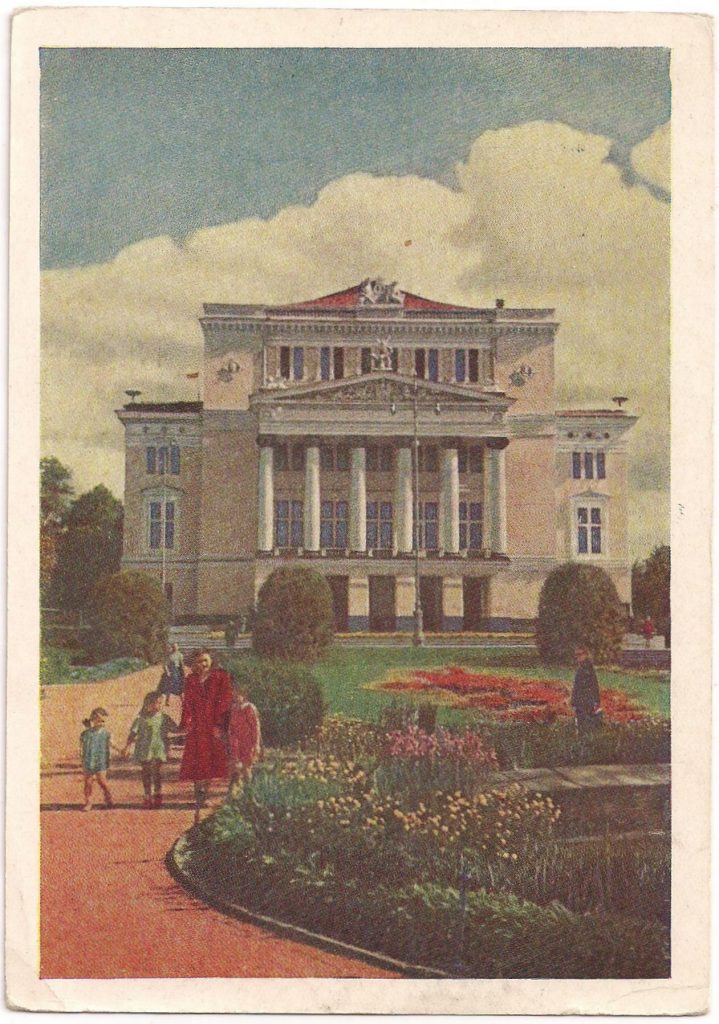 This card is an old card, the oldest, with a Latvian motif.
This card is an old card, the oldest, with a Latvian motif.
The card is issued 17/VI 1954, and with the money reform the card get a stamp. From 1-1-1961: 10 old kopeken are 1 new kopeke. The stock picture cards with imprinted stamp of the miner get an overprint ‘From 1 januari 1961 [is] price of the card with stamp 4 Kop.’ (P249-P250 with overprint in box, and P256-P259 without box). The postcards with the Spasskitower as imprinted stamp -as these card- are also overprinted. Below the address side with imprinted stamp:
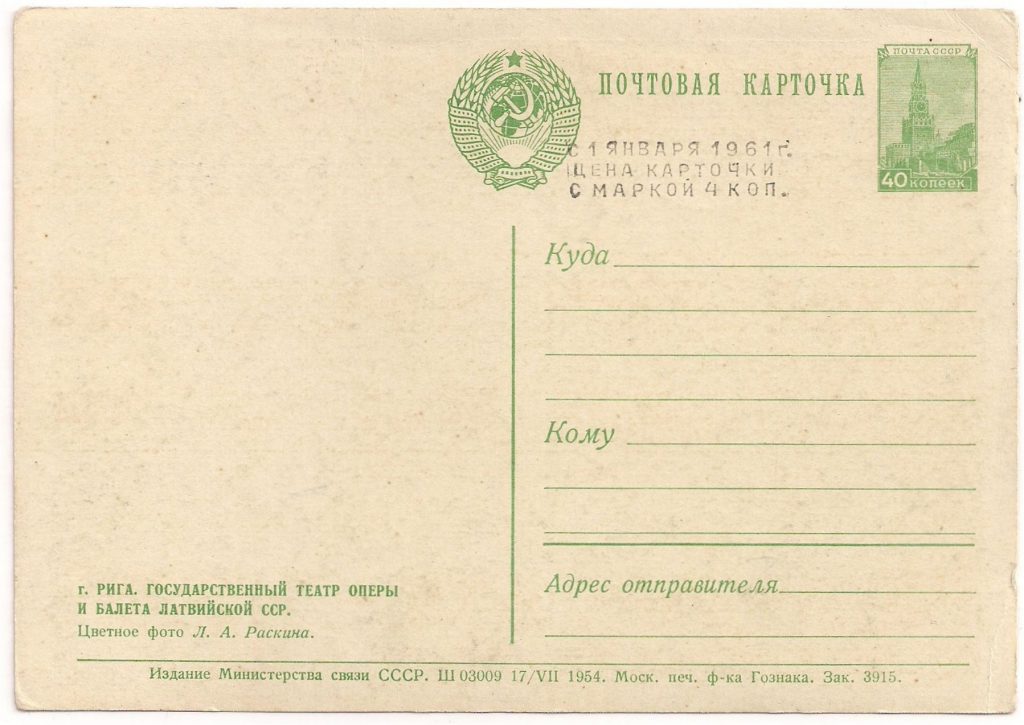
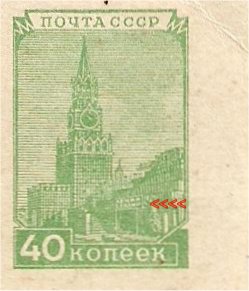 The imprinted stamp exist in more types: on the mausoleum 1 or two lines: Lenin or Lenin and Stalin. On the stamp here you see >>> two lines, the indication for Lenin and Stalin.
The imprinted stamp exist in more types: on the mausoleum 1 or two lines: Lenin or Lenin and Stalin. On the stamp here you see >>> two lines, the indication for Lenin and Stalin.
There is also a difference in printing: Type I: Typography, only vertical lines in the tower (inscription on the mausoleum 1 line: Lenin).
Type II: Typography, only vertical lines in the tower (inscription on the mausoleum 2 lines: Lenin and Stalin).
Type III: Offset: vertical and horizontal lines in the tower (only inscription with 2 lines, Lenin and Stalin)
So this stamp is type III: offset.
 The description of the picture – the Theatre in Riga- is only in Russian. Later cards have also a description in Latvian.
The description of the picture – the Theatre in Riga- is only in Russian. Later cards have also a description in Latvian.
At the bottom of the card: the printing data in one line:
![]()
 The coat of arms has a total of 16 ribbons and text in one line as points: so type IVC (in the Michel Ganzsachen-Katalog). The coat of arms: has left and right ribbobs and 1 ribbon at the bottom, with a text or a text only by dots indicated text.
The coat of arms has a total of 16 ribbons and text in one line as points: so type IVC (in the Michel Ganzsachen-Katalog). The coat of arms: has left and right ribbobs and 1 ribbon at the bottom, with a text or a text only by dots indicated text.
Type IV: 16 ribbons (1946), the number of union republics
IVA with two line text
IVB also two-line, but points
IVC single line: points, on this card above
TYPE V: 15 ribbons (1956), the Karelo-Finnish SSR in 1956 incorporated into the Russian SFSR VA with two line text
VB also two-line, but points
VC single line: points
The text: “Proletarians of all countries unite”.
In the Michel Ganzsachen-Katalog (MGK) the postal stationery cards are classified according the series permanent postage stamps. In the 8th serie permanent postage stamps (1948-1960) are three stamps used for the postal stationery cards: the Spasskitower (mi. 1336), the coat of arms (mi. 1335) with and the miner (mi. 1331).
For cataloguing we need also the coat of arms types, mentioned above:
| Stamp and type | Address and sender |
Other | Coat of arms type |
Printer | MGK | Sub | Year |
|---|---|---|---|---|---|---|---|
| Spasski-tower I | No lines | only two pictures | IV A | —- | P212 | —- | 1952 |
| Spasski-tower II | —- | IV A | —- | P213 | a, b | 1952/ 53 | |
| —- | IV B | —- | P214 | a, b | |||
| Spasski-tower III | printing address side: blue | IV C | —- | P215 | I, II, III | ||
| printing address side: green | —- | P216 | I, II | ||||
| Spasski-tower III | Address 7 lines, sender 2 lines |
printing address side: blue | IV A | МОСК. ПЕЧ. Ф-КА ГОЗНАКА |
P217 | IA, IB, IIA, IIB | 1952/ 53 |
| printing address side: blue | IV C | P218 | I, II | 1954 | |||
| printing address side: green | IV C | P219A | I, II, IV, V, VI | 1953/ 56 | |||
| milled border (from booklet) | P219B | I, II | |||||
| Spasski-tower II | —- | IV B | P220 | I, II | 1954/ 56 | ||
| Spasski-tower III | 1 picture (1954 and 1956) | IV B | М Т ИМ В. М. Г… | P221 | —- | ||
| Spasski-tower III | Address 7 lines, sender 2 lines |
—- | V B, green | МОСК. ПЕЧ. Ф-КА ГОЗНАКА |
P222A | —- | — |
| milled border | V B, green | P222B | —- | —- | |||
| Spasskitower II | —- | V B, green | P223 | —- | —- | ||
| Spasski-tower III | —- | V B, red | P224 | —- | —- | ||
| VI World Youth and students.. | logo | —- | P225 | I, II, III | 1957 |
The card above has lines for address and sender, coat of arms IV C and printed in green: must be P219 A.
The sub-division:
I: Publication-number: A…
II: Publication-number: Ш…. and a.white to ‘vivid grey-yellow’ b. vivid brown cardboard
IV: Publication-number Ш……, with date and issue-year 1954.
V: Publication-number A…., with date and issue-year 1954
VI: Publication-number Ш, with date and issue-year 1955
The card above has as publication-number Ш 03009, with date 17/VII and issue-year 1954: P219A, IV.
MGK (Michel Ganzsachen-Katalog) mention under P219A, subdivision IIa cards with picture. Here also the interesting card ‘Lenin-Stalin-Mausoleum (5/VIII 1954)’. The picture of this card has above the mausoleum clearly indicated Lenin and Stalin.
More about this: another site
1957
РИГА. В ГОРОДСКОМ ПАРКЕ,
(RIGA. V. GORODSKOM PARKE, Riga. In the city park)
Without production number
P224 IIa.

The address side of the card:
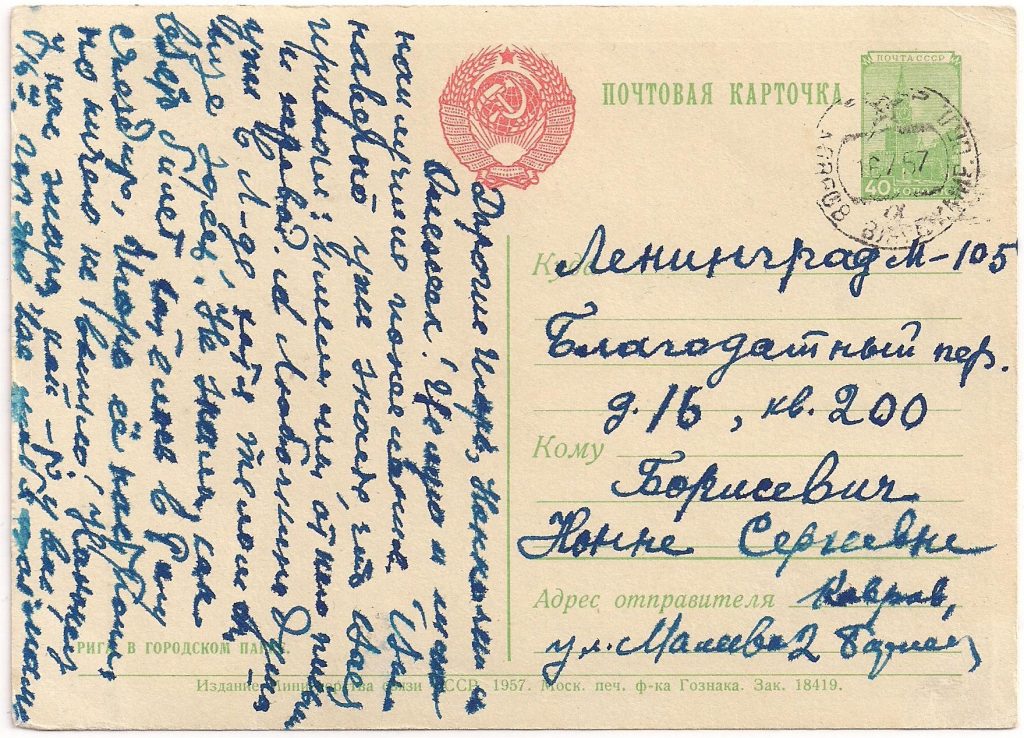
1959
ЛАТВИЙСКАЯ ССР. КУРОРТ КЕМЕРИ [KURORT KEMERI]
БЕСЕДКА НА ОСТРОВЕ (Pergola on the island)
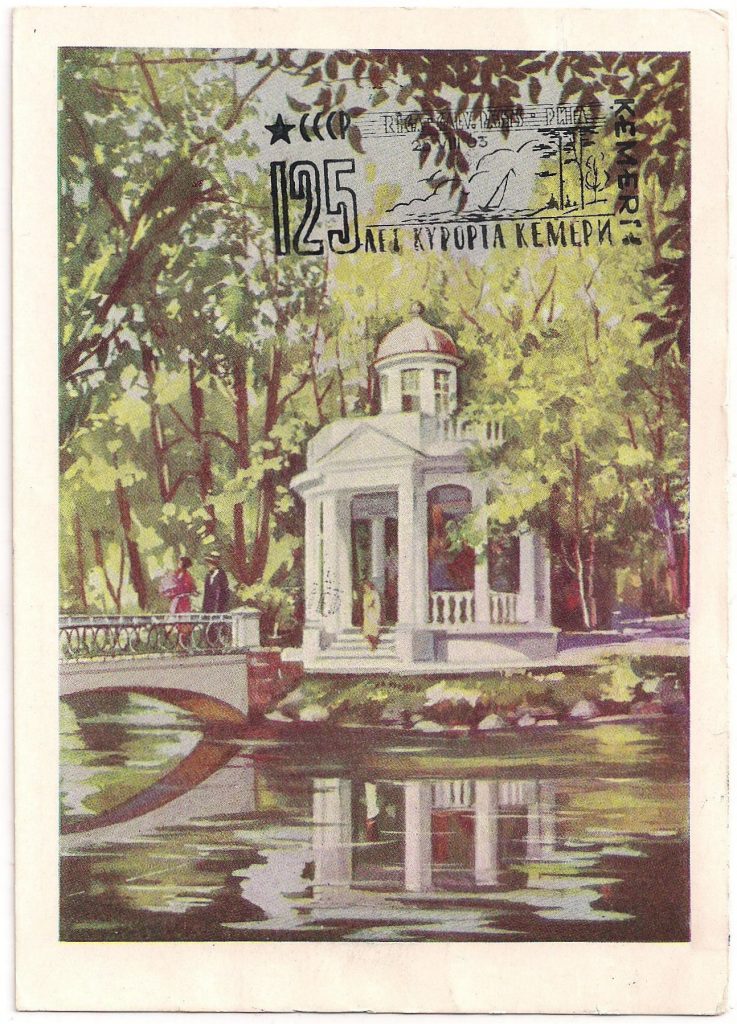
About Ķemeri:
Ķemeri, kuuroord sinds 1838 / Jan Kaptein. – In: HBG 2009 ; 55. – p. 4-14 (article in Dutch)
The address side of the card:
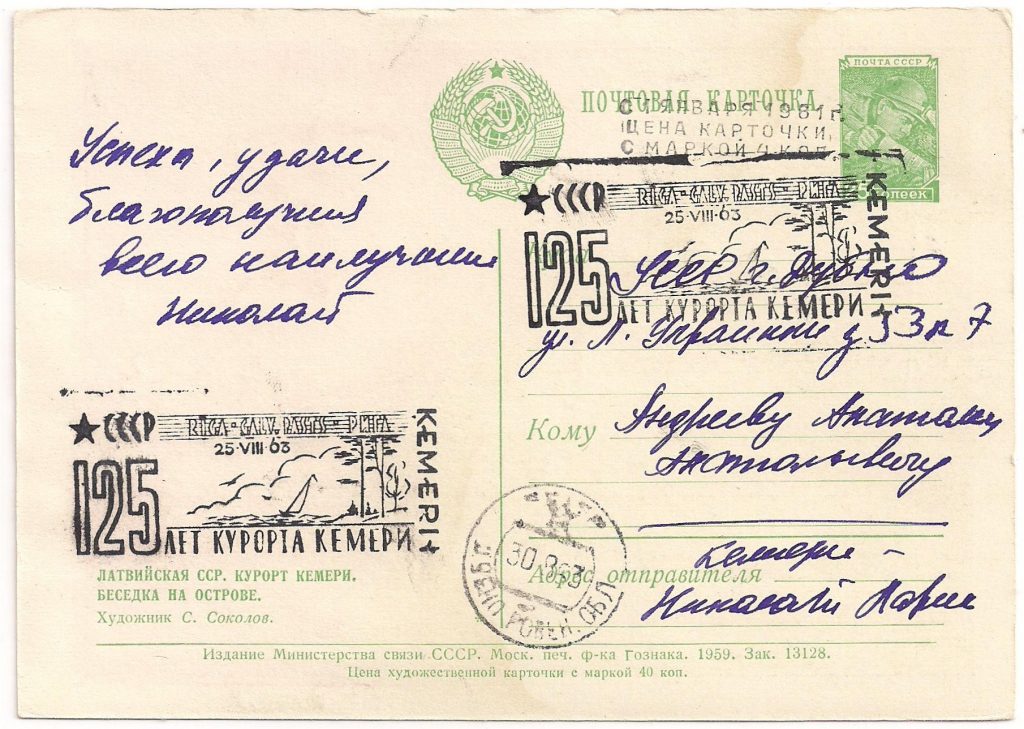
With postmark money reform 1961. With special stamp 1963: 125 year
1961
LATVIJAS PSR. RĪGAS JŪRMALA
Without production number
P285 III
About Jūrmala:
De Baltische Riviera : deel 1/ Jan Kaptein. – In: HBG 2008 ; 53. – p. 4-16
Part 2 In: HBG 2009 :54. – p. 4-23
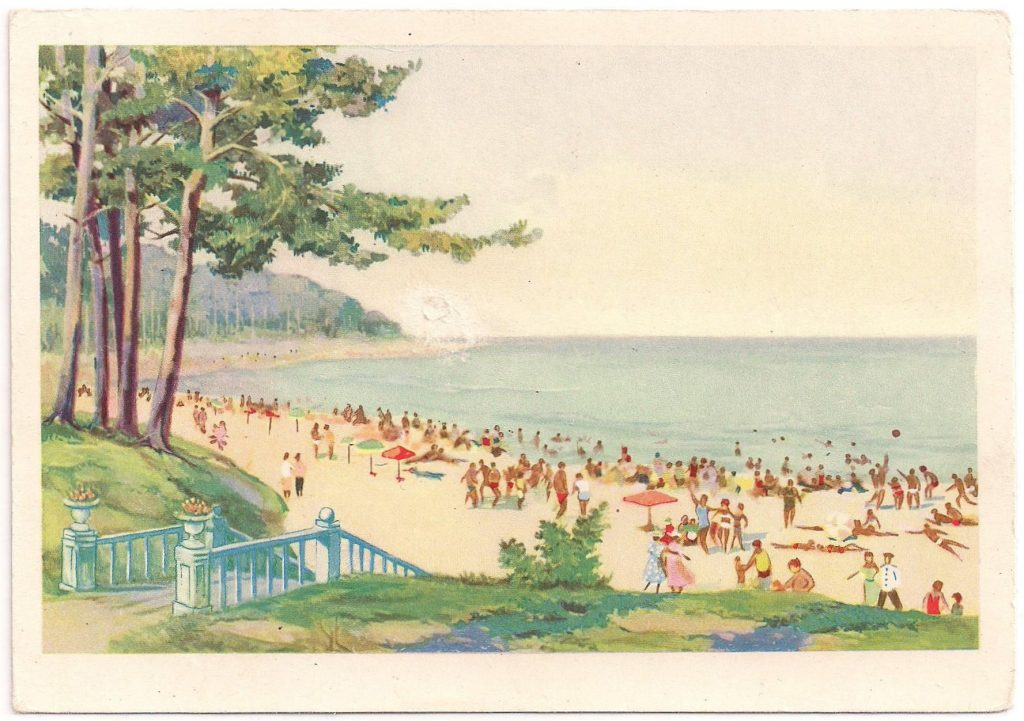
The address side of the card:
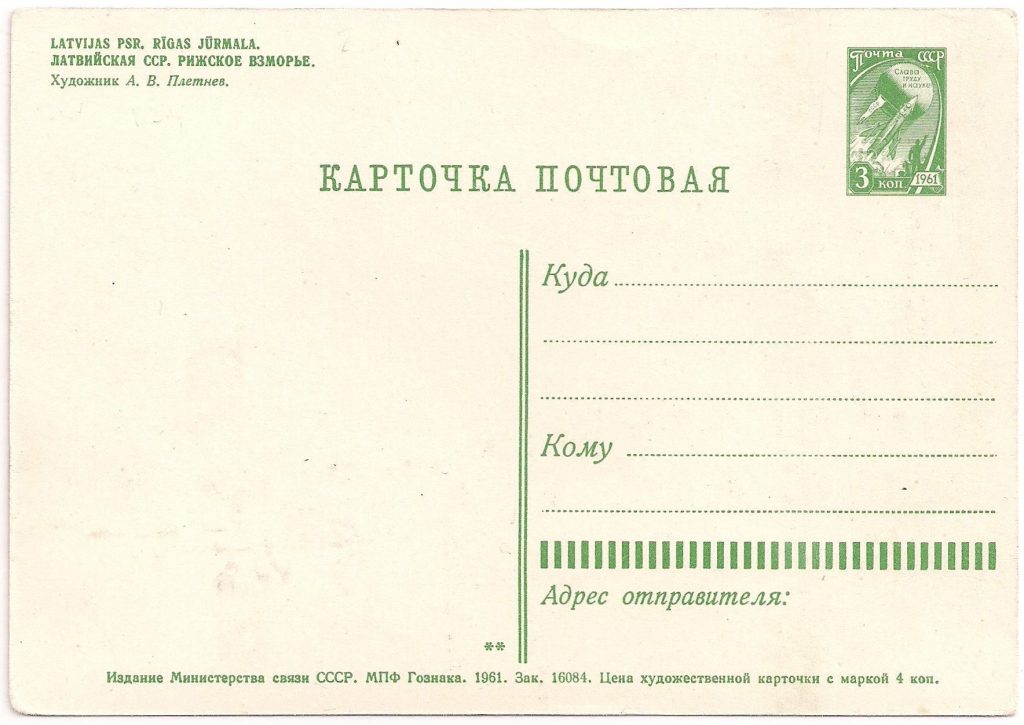
On the address side of this card is indicated -bilingual-: ‘LATVIJAS PSR. RĪGAS JŪRMALA’ . Also the художник (=artist) is mentioned here.
On the bottom line we see the printing data.
The card is issued in 1961 and printed in the МПФ ГОЗНАКА, the abbreviation for МОСКОВСКОЙ [MOSKOVSKOI] ПЕЧАТЉОЙ [PECHATNOI] ФАБРИКЕ [FABRIKE] ГОЗНАКА [GOSZNAKA], Moscow Printing Factory Goznak.
Number 16084 is the number of the ЗАКАЗ [ZAKAZ], order.
A stamp of the 10th series permanent postage stamps, with the year 1961, is used as a stamp: a starting rocket.
In MGK 2004/05 four types of this stamp are distinguished:
I Letterpress (lines on background and moon with greater distance from each other)
II Offset printing (background and moon with finer lines)
III Offset printing (finer lines on the background, moon without lines)
IV Grid gravure (background and moon: grid)
This postal stationary with МПФ ГОЗНАКА and imprinted stamp Type II is in the Michel P 285, subnumber III (only the year, not a number starting with A in the printing data).
About the picture postcards with imprinted stamp:Postwaardestukken uit de Sovjetperiode : ansichtkaarten / Jan Kaptein. – In: Het Baltische Gebied 2012 ; 60. p. 4-25. – Article in Dutch
After the printing data Na de drukgegevens on the line at the bottom is still mentioned: ЦЕГА ХУДОЖЕСТВЕННОЙ КАРТЧКИ Р МАРКОЙ, Price of the artistic card with stamped stamp. And that was 4 kopecks.
In 1946 Rīgas Jūrmala is added to Riga as 7th district. Ķemeri en Sloka were – and remained – autonomous. In 1959 Jūrmala became a city, including Ķemeri and Sloka.
6/I 1962
LATVIJAS PSR. RĪGA. PILSĒTAS PARKĀ.
A 01618
P285 II (34 little lines)
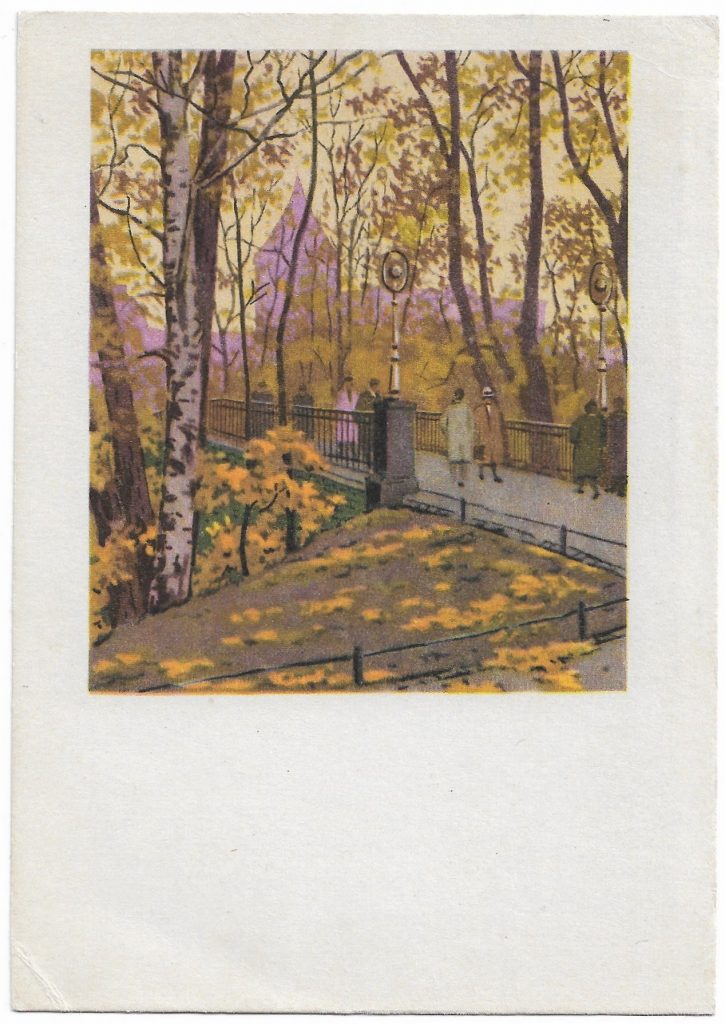
The address side of this card:
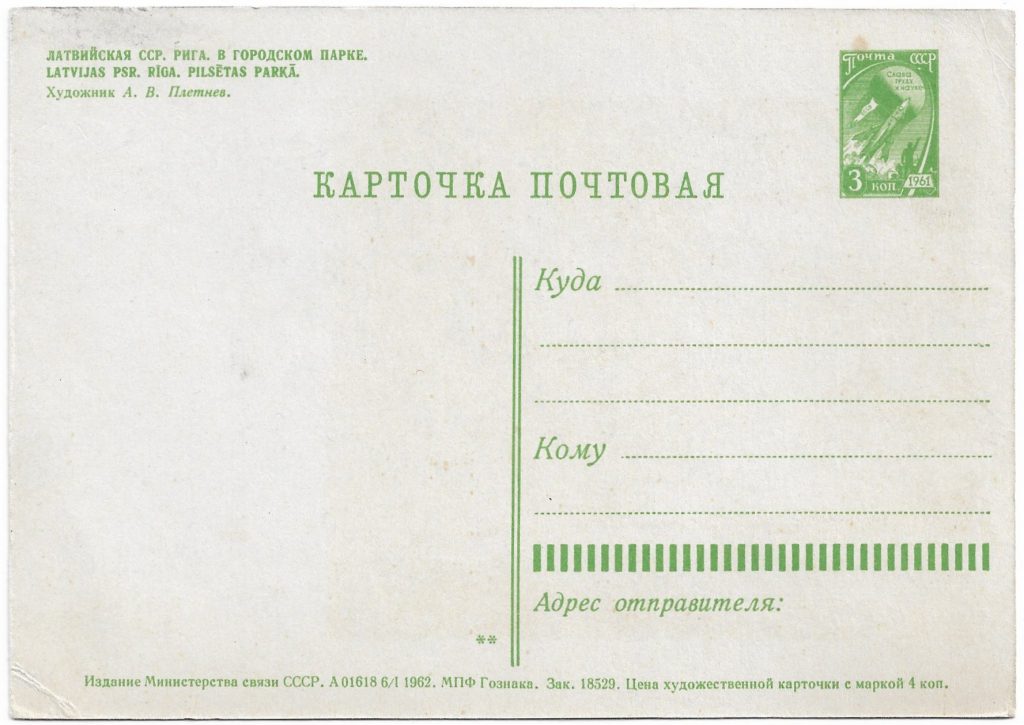
On the address side of this card is -bilingual- indicated: LATVIJAS PSR. RĪGA. PILSĒTAS PARKĀ. Also the художник (=artist) is mentioned here.
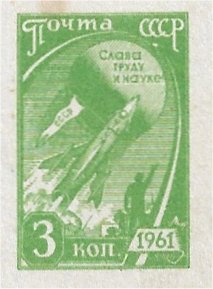 A stamp of the 10th series permanent postage stamps, with the year 1961, is used as a stamp: a starting rocket.
A stamp of the 10th series permanent postage stamps, with the year 1961, is used as a stamp: a starting rocket.
In MGK 2004/05 four types of this stamp are distinguished:
I Letterpress (lines on background and moon with greater distance from each other)
II Offset printing (background and moon with finer lines)
III Offset printing (finer lines on the background, moon without lines)
IV Grid gravure (background and moon: grid)
Four series of ‘zweiseitige’ [double-sided] postcards with this stamp have been issued during this period:
1. In 1961 with state arms in the middle above the –single one- dividing line between the address data and the written message from the sender, printing data in 2 lines. In MGK: P 276-277.
2. In 1961-1967 a double dividing line between the address data and the message, printing data in 1 line, for the printing house is used the abbreviation МПФ ГОЗНАКА. On the right 34 vertical little bars between the address data and sender data. In MGK: P 282-287
3. In 1961-1967 similarly, but the printing house in full: МОСКОВСКАЯ ТИПОГРАФИЯ ГОЗНАКА or the abbreviation of this. In MGK: P 288-293
4. In 1964-1966 the printing house ППФ ГОЗНАКА. On the right 32 vertical little bars between the address data and sender data. In MGK: P 294
This card (and the previous one) fall under the second group: P 282-287.
Schematic: Without state arms and printing house МПФ ГОЗНАКА
| Druk | Stamp type | Color | MGK | Printing data, subdivision | Year | |
| Letter-press | I | Green/ white |
P 282 | See below | 1961/67 | |
| Violet/ white |
P 283 | I With price | II Without price | |||
| I with rectangle 23:30 in luminescent yellow | Green/ white |
P 284 | ||||
| Offset | II | Green/ white |
P 285 | See below | ||
| Red/ white |
P 286 | |||||
| II with rectangle 23:30 in luminescent yellow | Green/ white |
P 287 | ||||
This card, P285, but also this number from MGK is again subdivided in 4 types:
I The printing data with Nr. A…, with date, with year of issue 1962-1964
II Nr. A…, with date, without year of issue
III Without indication Nr. A…, without date, with year of issue 1961
IV With Nr. A…, with date, without year of issue, but with 33 vertical little bars between the address data and sender data (instead of 34)
The subdivision of P 282 in 4 types:
I The printing data with Nr. A…, with date, with year of issue 1962-1964
II Nr. A…, with date, without year of issue
III Without indication Nr. A…, without date, with year of issue 1961
IV Without indication of printing data
VII 1962
Latvijas PSR. Majori. Viesnīca.
A 06676
P285 II (34 little bars)
Majori is the central district of the seaside resort of Jūrmala. Below an image of the hotel ‘Majori’.
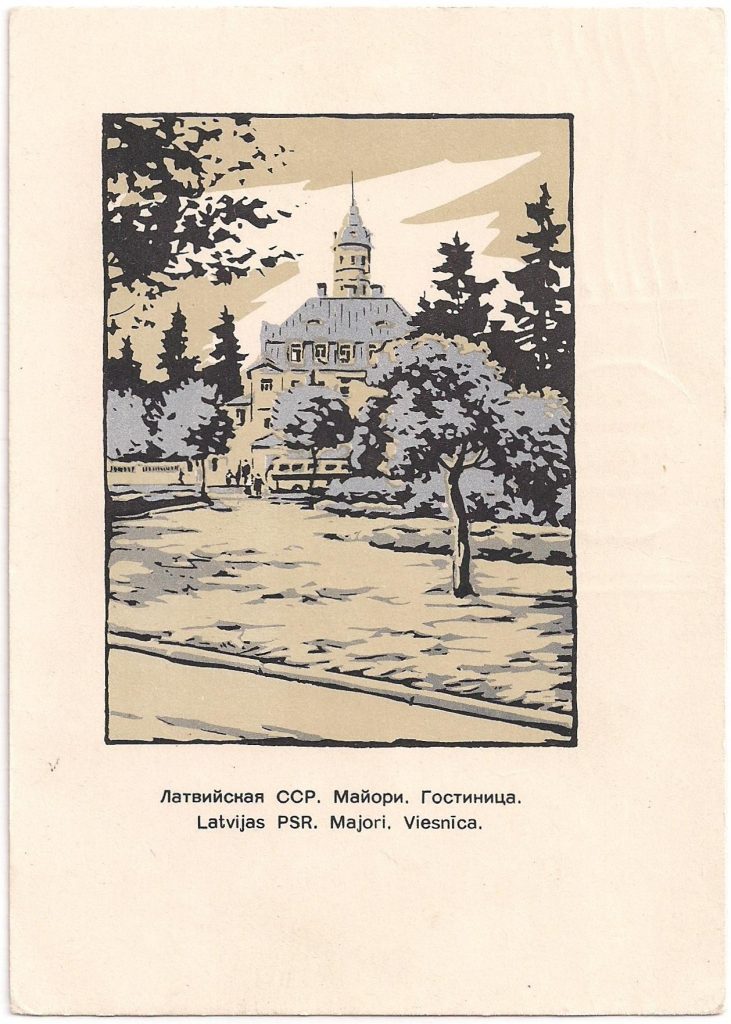
The description of the image is now placed on the image side. Viesnīca is the Latvian designation for hotel. The well-known hotel “Majori” was built in 1925 under the guidance of the architect A. Medlinger in an ‘Art Nouveau’ style (or ‘historicism’ style). In the crisis of 1932 the hotel had to be auctioned. The precious interior went partly to castle Sigulda. In 1991 the hotel was renovated.
The address side:
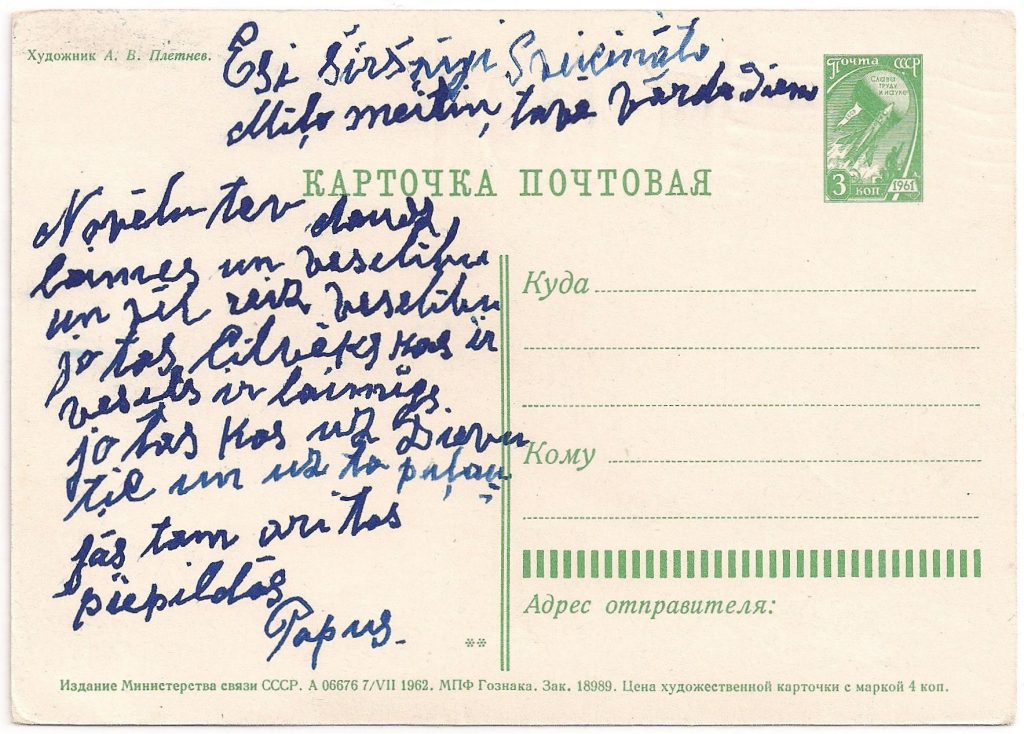
5/X 1962
Lielupe Sanatorija ‘Rigas Jurmala’
A 07520
On the eastern edge of Riga’s Jurmala lies the fishing village of Buļļi (Bullen), now Lielupe. The description of the image is now on the front.

The address side:
